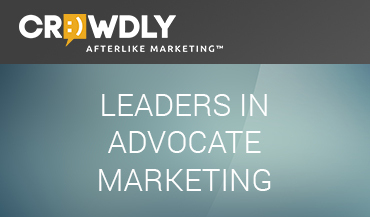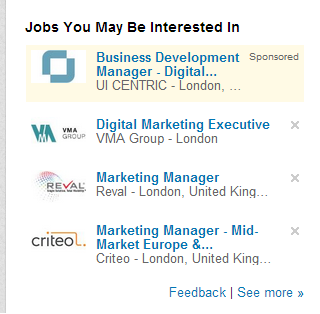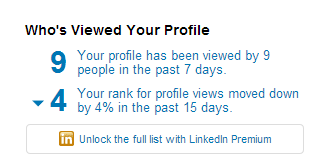Erik Qualman's Blog, page 588
September 9, 2014
Leaders in Advocate Marketing: Q&A with Hessie Jones

 Over the past four weeks, we have sought out the best-of-the-best social media marketers for an executive Q&A. These industry leaders are giving their advice on the future of advocacy and influence, along with detailing how brands can activate their most effective advocates.
Over the past four weeks, we have sought out the best-of-the-best social media marketers for an executive Q&A. These industry leaders are giving their advice on the future of advocacy and influence, along with detailing how brands can activate their most effective advocates.
This week, we sat down with Hessie Jones, CEO of ArCompany. Hessie currently helps companies realize the value of social intelligence and its effects on the inevitable next level: the operationalization of social. She is also a cellist, a seasoned digital strategist, a marketer, a writer, a speaker, a podcaster, a social media addict, a wife and a mom.

Hessie Jones is the CEO of ArCompany and a contributor to Steamfeed and the Huffington Post
1. If advocacy means genuinely believing in and supporting a brand (via social sharing, WOM, etc.), what brands would you consider yourself an advocate of? Why do you advocate for these brands?
I’m not a true advocate of brands, per se. There are so few who do it well consistently. A few who’ve done some amazing things include @ToscaReno and @EatCleanDiet. Tosca and her team built an organic community from scratch, nurtured it along the way (on both Facebook and Twitter) and never purchased ads to buy ‘Likes’ or Followers. Considering that she’s amassed over 80k genuine followers collectively on Twitter and over 450K on Facebook is testimony to how you can build community the right way. While Tosca is a client, I’ve gotten a first-hand look at the incredible engagement of her community, including when she’s speaking, when she’s taking a selfie, or when she’s celebrating personal milestones. I’ve met her in person and she’s truly the down-to-earth, caring individual she portrays on TV. My team has developed strategies that keep Tosca engaged with her fans, and she not only hops on board; she’s excited and delighted to participate in the brainstorm. I recently wrote a post about how the community stayed with her even when she went dark on social, helping her bounce back.
For brands that have the dollars to do larger scale spectacular things, I would also say that Red Bull has marked the standard as one brand that has evolved from a product company into a true media company. It leads with content and embraces its brand values in all its awesome executions, both online and offline. Red Bull has created markets and advocates for its brand by virtue of its content. This is truly one company that knows how to bring its product to the customer.
2. In addition to social marketing, how can brands develop an integrated strategy that includes advocate activation?
The best way to activate advocates is always through personal outreach. If you can send personal emails that identify and celebrate each individual and his or her unique dedication or contribution to moving the brand footprint, that’s always the best approach. What’s even better is to send a personal gesture/gift to reward them for advocacy – as long as you have access to their mailing address.
Quarterly focus groups where brands can meet advocates in person can also be scheduled to allow customers to be exposed to “test” products. These customers can then evaluate current services and provide out-of-the-box suggestions for marketing the product to the company’s marketing/PR team, building customer advocacy and providing valuable feedback for the brand.
As part of an integrated strategy, brands should also seek to improve aspects of their business around the product or service. They should always leverage advocates to voice “candid” opinions in these areas. This ends up being less of a marketing campaign, and more about how customers can give the necessary information to be better as a company.
Lastly, I’ve seen brands develop a forum on their website and ask specific questions to their customers. To do this from scratch means initially seeding questions and driving advocates to the forum, and then continually pushing and incentivizing activity until momentum naturally develops. This requires a lot of work, but “owning” the community on the website will yield much higher returns organically with traffic and increased conversion probabilities.
3. We believe that Facebook is the best social network on which to find and nurture a brand’s advocates. Do you agree with that? Why or why not?
I used to believe that. As a marketer, I loved Facebook Pages to be able to interact, crowdsource and develop custom campaigns for my most loyal fans. These days, Facebook’s pay-to-play methods make it increasingly difficult for marketers to truly get in front of their fans. It also makes it much more expensive. I do agree, however, that there are pages that get amazing visibility because of their content and because their fans are truly engaged: The Onion, I F**king Love Science, Coca Cola and KLM are companies that stand out for me as amazing brands on Facebook.
4. Have you seen any brands that truly have visionary senior executives when it comes to brand advocacy and social adoption? What makes them visionary?
The best visionary I’ve seen is Richard Branson with Virgin. He’s one to challenge the status quo. Coming out with a risqué brand called “Virgin,” especially in a time that did not quite embrace this method of boldness, was daring. Branson is in tune with the market and creates brand extensions where none naturally exist. Using the Virgin label as an extension to cell phones and radio stations can leave people initially scratching their head, but Branson makes it work, and market acceptance and customer advocacy is consistently a result. If it doesn’t work, he doesn’t hesitate to change things. Richard is an individual that, in my opinion, is a global change maker and leader. One of the most successful and profitable billionaires, he truly leads an organization where employees are his priority. I love this quote that embodies his view of company success through employee and customer advocacy: “(Richard’s) business maxim is staff first, customers second and shareholders third. His company is described as a friendly, nonhierarchical organization where people enjoy themselves.”
5. On LinkedIn, you cite the quote “A social business is one that becomes engaged, transparent and nimble” by John Mell of IBM. What large companies have you seen do a great job of this? How did they do a great job?
Again, Virgin Mobile fits this mold perfectly. Richard Branson doesn’t necessarily believe in a hierarchical structure. He encourages employees to come to him directly with ideas and issues, but he also instills a culture more attuned to change. Employees are encouraged to think outside the box and he nurtures the “maverick” quality that allows anyone to push the envelope.
The Virgin team understands the value of content: When Virgin Mobile launched their “Live” social newsroom, it became the go-to hub to consume new apps, music, web memes and content. This was shared across social platforms (Facebook, Twitter, Instagram) and BuzzFeed. Virgin Galactic is absolutely insane and brilliant; imagine having the chance to go into space for a mere $250K.
Virgin is also one of the most transparent brands. They are honest about their trials and tribulations and actively share these with their customers. Since Virgin prioritizes its employees first, you can guarantee that your experience with any Virgin Mobile product/service will be superb.
[image error]
Some of the Best Safety Apps

Nowadays there are apps for just about everything, and while some of them are nothing more than fancy advertisements or a quick way for the developer to make lots of money, there are a lot of apps out there that are really useful in everyday life, including improving everyday safety. Below describes a few outstanding safety apps that feature must-have tools for every safety professional…
If you’re working in an industry that requires manual lifting of heavy boxes, the safe lifting calculator is a useful app to have. The app indicates where your lift begins, estimates the number of lifts per minute and the hours of lifting per day, and then calculates the maximum safe lifting weight accordingly, to help to avoid any injuries from over-exerting yourself. The app is free and easy to use as it only takes 10-15 seconds to make a lifting calculation. What is more, you can guarantee an accurate calculation because it is based on the NIOSH lifting equation. The app is ideal for any employees and supervisors where manual lifting is required.
The asbestos inspection app is free and can help anyone who is concerned about the presence of asbestos in a building. The app is simple to use as it just requires you to take a picture of the suspected asbestos area and then send it on to one of the specialists who created the app. They will then examine the photo and get back to you with a professional recommendation. However, while this app is helpful for the initial diagnosis of asbestos, it is a legal requirement to invest in asbestos awareness training if you are likely to disturb asbestos as it can be very damaging and sometimes fatal to your health.
Risk assessments in the work place are essential and could potentially save the life of someone. The Risk Assessor Lite app makes creating a risk assessment much easier because it produces the risk assessment report for you. All that is required from you is to take a photos of the area with potential threats and drag and drop the pre-loaded risks over the photo. Then you have to select the most relevant control measure, the worst case outcome and the likelihood and then it’s complete. So you will no longer need to produce lots of paperwork yourself, as a fully personalised PDF Risk Assessment report is created.
American Red Cross First Aid app
There are plenty of first aid apps available but it is difficult to find one that actually fulfils its purpose. However the first aid app created by American Red Cross successfully includes expert advice for everyday emergencies so that you can be prepared for any occasion that life may bring in the workplace. The app is media rich making it an engaging and easy to understand – for example it features videos, quizzes as well as step by step guides clearly informing you what to do if a particular situation should arise. Furthermore, the app is free so the safety of you and your employees doesn’t come with a price tag.
So now that you’ve read about some of the best safety apps that are around at the moment, test some of them out by downloading them to your smartphone and see how it can help to improve the safety in your workplace.
[image error]
September 5, 2014
How to Make Social Media Interesting for Niche Companies

We’ve all heard about the supposed miracles social media can work for a company, the statics support the hype with 87% of SME’s claiming social media has helped their business. But in reality is social media applicable for every business type? Various companies have managed and by following a few simple principles most companies can create exciting content no matter what product/service they offer.
Rule number one, is that you’ve got to have fun.
Social media is inherently fun – it’s what people do in their spare time, the whole reason for its existence is basically entertainment and occasionally human connection. If the content you’re creating isn’t fun and easy to digest then it’s unlikely to generate much engagement and will likely get scrolled past. If you have fun creating it, other people will probably have fun viewing it. If you can make your content genuinely useful and informative as well as fun and accessible then you’re on to a winner.
Put the Time in
On the surface, a product or company may not seem like it easily lends itself to social media, but it just takes some time and effort to come up with an angle which could work. For instance the Ladder Association; ladders are not necessarily the most gripping content but they launched a campaign to find the biggest “ladder idiot” and asked the public to send in photos and vote – managing to make ladders fun and engaging. Committing time and effort to your social media strategy really does pay off; 74% of businesses when they invested 6 hours a week into social media they saw a significant increase in website traffic.
Don’t be afraid to cater to your Audience/Industry
Of course you want some of your content to be aim at anyone who might come across your company but don’t let that scare you off from going a little niche. You target audience are the ones most likely to end up following your social media efforts, you’re an authority in your industry why not share your expertise and maybe make some inside jokes?
For instance, Pegasus Health a company specialising in horse supplements recently made a blog post about the appropriate use of Twitter in the riding community. Whilst on the surface horse supplements may not seem like the most riveting topic worthy of its own blog and social media effort, they know their audience and have aligned their efforts with the riding and horse enthusiast community – they even sponsor an international show jumper and have him write guest blog posts for their website.
If there’s an industry event or news be sure to involve yourself in it, social media is as much about entertaining and engaging your target audience as it is about appealing to new potential followers – it’s also about establishing yourself as part of the online community in your industry.
Your company may be well known and respected offline but unless you’ve put the time in this won’t instantly transfer to the online world. You have to establish yourself and your company’s voice in the online arena/digital market as well as the general market.
[image error]
Grow Your Twitter Following- Do Followers Matter?

 It has been said that we place way too much emphasis on the topic of Twitter followers. Often when working with businesses on their social media campaigns, they ask me how they can get more Twitter followers. In fact, most seem overly concerned about how many followers I can get them, like it’s some kind of contest or race.
It has been said that we place way too much emphasis on the topic of Twitter followers. Often when working with businesses on their social media campaigns, they ask me how they can get more Twitter followers. In fact, most seem overly concerned about how many followers I can get them, like it’s some kind of contest or race.
However, I don’t believe the number of followers matters as much as some companies still want to keep thinking it does. You can talk to people on Twitter using the @ without following them and you can follow hashtags and jump into related conversations without following all the people involved in the conversations. Most people who use Twitter regularly these days do so with apps or tools to make it easier to communicate this way. Very few people still use Twitter from the web browser the old school way.
You should know that buying fake Twitter followers doesn’t help much at all in terms of boosting interaction on your Twitter account and it won’t do a thing for helping you increase sales from those followers.
So this would beg the question- why do people keep buying followers? The answer to this lies in the form of a question itself.
Would you be more willing to buy from a company with 300 followers or 30,000?
There is still a belief (whether true or not) that more followers means a company is more well known or liked. It is a status symbol. People still think if you have a large number of followers, it must mean you are doing something right. As long as this belief is out there, you will have people who buy Twitter followers.
So let’s look at some of the downsides. Some people worry that it will hurt your credibility if your actual followers and customers find out you have buffed up your numbers unnaturally. Some people say it’s such a terrible thing to do, that people will not trust you or your business. A good point to bring up, however, would be how your customers would know. Are they personally doing research to see if all of your followers are real? Probably not.
Some people worry that their Klout or Kred scores will be affected by purchasing fake followers. That’s a legitimate concern since it seems that it would and sites like StatusPeople create tools to help you see who has fake followers. However, one man did his own little experiment back in 2013 and the results may surprise you. Jim Tobin found out his Klout and Kred barely changed at all when he purchased 10,000 fake followers on Twitter. His conclusion: It didn’t help or hurt him.
So at the end of the day, if you want to grow your Twitter following, go for it! How you do it is up to you and there’s really no guarantee that the number of followers you have will really help or hurt you in any major way anyway. At very least, it will create the impression of popularity for your account.
[image error]
Leaders in Advocate Marketing: Q&A with Michael Brito

 For this week’s advocate marketing Q&A, we sat down with Michael Brito, group director at WCG, a W2O company. We started this series in partnership with the leading advocate and influencer marketers to help brands understand the word of mouth landscape and how to drive the best results across social, email and all customer engagement channels. The social media leaders we’re interviewing will give their advice on the future of social media advocacy and influence, along with detailing how brands can activate their most effective advocates.
For this week’s advocate marketing Q&A, we sat down with Michael Brito, group director at WCG, a W2O company. We started this series in partnership with the leading advocate and influencer marketers to help brands understand the word of mouth landscape and how to drive the best results across social, email and all customer engagement channels. The social media leaders we’re interviewing will give their advice on the future of social media advocacy and influence, along with detailing how brands can activate their most effective advocates.
At WCG, Michael is responsible for helping clients transform their brands into media companies by implementing social business strategic initiatives that operationalize content strategy, scale community management and integrate paid, earned and owned media initiatives. Michael believes that marketing can be evil at times; but if done right, it can drive customer loyalty, product innovation and brand advocacy. He is confident that if brands love their customers they’ll love them back and tell others about it.

Michael Brito, Group Director at WCG, a W2O Group company, Author of "Your Brand, The Next Media Company."
1. We’ve seen some brands with extremely smart digital and social teams, but poor support at the senior executive level. How important do you think it is to get people at the top as excited about advocacy and community building as those in the trenches, and how can they achieve that?
It’s imperative to get buy-in from management to do anything from changing an existing data center, to email programs, to focusing on building brand advocates. Management not only controls the budget, but they also control the mindshare of other executives, and the company itself. Without executive buy-in, the likelihood of the program dying in three, six or twelve months is likely because these programs require dollars and investment.
When obtaining executive buy-in on advocacy programs, it’s important to keep in mind that if you have an investment that’s only meant to last a year, you’re gambling because advocacy programs are meant to live forever. Advocacy can’t be tackled in a short-term initiative, because you’re talking about mobilizing and empowering people who already love your brand, and then amplifying their voices continuously over time.
When it comes to proving the value of advocacy, we all know that there’s often a sense of abstract business value. This abstraction doesn’t work for executives. Through word of mouth, advocates are indirectly selling products on your behalf without you asking them to do so, and lots of companies do this very well today. To convince executives, you need to do two things; 1) measure clicks, purchases and the share of voice around products and certain verticals, giving executives the assurance they need that programs like this can actually be tracked, and 2) show them that other companies are seeing success in their advocacy programs.
2. When developing an advocacy program, should companies opt for a pilot program or an annual budget?
It depends on the culture of the company. Either way is a good approach, but both have potential setbacks. With the pilot approach, if the results don’t appeal to management, the program will quickly die. On the other hand, with an annual investment, you face the potential for greater failure if you don’t see the results you were aiming towards at the end of the year.
The best end results come from an approach combining a pilot with an annual budget. Start small and establishing some success and best practices. After proving successful with the pilot and reaching a certain benchmark, make sure that you have commitment from management to move towards an annual budget. Having that commitment is important from a morale perspective, as it helps whoever owns the project feel confident in the work that they’re doing. It is also important from an advocate perspective, because, as I mentioned before, building an advocacy program then killing it six months later is not a smart business practice.
3. What do you consider the main difference between advocacy and influence?
At W2O, we look at influence with a laser-focused lens using a model we call “1 9 90.”
Influencers: the one percent
For any topic, country, geography, or any specific cause, one percent of the people typically drive the conversation; those people are the influencers. This goes for data centers, social business, social media or travel, where one percent of the population is driving the conversation. These influencers are important, sometimes high maintenance and sometimes cost money, but they are the people that create the conversation other community members look for.
Advocates: the nine percent
Then, there is the nine percent — your advocates. These are people talking about your brand, regardless of whether or not you engage with them or are even listening.
Consumers: the ninety percent
Finally, the 90 percent represent everybody else — the consumers.
What’s interesting about the nine percent is that they are getting information from the one percent. This means you have to figure out how to deliver some value to your one percent, because they’re going to affect the nine percent, which in turn, affect the 90 percent. There is a trickle-down effect, and in some cases, there is crossover, such as when the nine percent are influencers on some topics, but not others. However, the main difference between the one and nine percent is that the one percent usually requires some type of incentive — they may require you to pay them, to see your product, to see your plans or be the first ones you loop in on a story. The nine percent don’t require the incentive. They love your product, and they feel an emotional or rational incentive, rather than one involving money, to talk about you.
Ultimately, if you can operationalize programs that empower your advocates to help tell the brand story, that’s when you begin to reach a critical mass for influence. The advocates will then affect the 90 percent, who are the lurkers or consumers of content, which drives the bottom line.
4. Have you seen any brands that truly have visionary senior executives when it comes to brand advocacy and social adoption?
Chili’s is doing advocacy really well. They have really operationalized their program and have a lot of engagement and sharing. Skype and other Microsoft products have also done well with advocacy through their MVP program.
5. In your blog post “Top 3 Considerations Before Launching a Brand Advocacy Program,” you used an H&R Block Case study as an example of a well-executed strategy. Are there any other brands you’ve seen activate their advocates effectively?
SAP has a thriving community network that gives them an opportunity to talk to their technology partners and customers, adding value through these community discussions. SAP also allows their community to share their content about how to solve different technology problems, which is a key component of advocacy, since it provides value to people in the community beyond just hearing about SAP promotions.
6. Who are your sources of inspiration?
Jeremyah Owyang is a social visionary who paved the way before shifting his attention to new endeavors. Jay Baer is another visionary, constantly shaping the discussion around advocacy and social marketing.
[image error]
September 2, 2014
How to use Linkedin to get your next job

In a tough economy, finding work placements and getting yourself out there can be hard work. Making yourself visible online can certainly boost your employment opportunities and this means being socially active on Linkedin.
Linkedin is the free online social network for work professionals. It is the ultimate online stage for self-promotion – a way to showcase your previous work experience and present yourself as a strong work candidate.
With over 200 million users all over the world, recruiters are looking at Linkedin to head hunt new staff and promote new jobs. Above all, most human resource practitioners are looking you up on Linkedin when they receive your resumé so being on there in the first place is essential.
Update your profile
When you sign up, Linkedin will first give you recommendations of people who you may know. These people will become your connections and Linkedin will use your email address to suggest other members you may know. You can chat to your connections and even rekindle some old friendships.
Updating your profile is easy. On the right hand side, the site provides a checklist of things that you should be adding to your profile including a Summary, Projections and Grades. It will give you a percentage score of how complete your profile is – something that I think Google Plus have picked up and emulated.
Apply for jobs
Using the Linkedin Resume Builder, you can take your profile that you’ve just uploaded and turn it into a nice looking resumé. Choose from a dozen formats to create a killer looking resumé that you can print off and take to your next interview.
Linkedin gives you the opportunity to apply for jobs that other companies and recruiters post. These job are suggested to you on the right hand side of every page and you can apply just one click away. In theory,you can apply for a 100 jobs in one morning. You can get very specific with the job you are applying for including role, salary and location. Once you fill in some details, you can then monitor the position on offer and even see how many other people have applied.
A nice trick is to change your work status to “Looking for a job in marketing…” or whatever your discipline. This is something that will scream out to potential employers and make you that little bit more noticeable.
Post regularly
It’s a great idea to post regularly on the newsfeed with things in your industry that interest you. It can spark debates and engage your connections and subsequently make people view your profile more.
See who viewed your profile
One of the most interesting things about Linkedin is the way you can see who has viewed your profile. Although there is an anonymous button in case you want to snoop around on some people you know, generally the link on the right hand side shows you exactly who was looking at your profile. This is a very exciting prospect and I can only imagine the outcry if Twitter and Facebook followed suit.
But this functionality is a great tool to see which recruiters and companies have been checking you out and you can use this as an invitation to follow up on any job prospects moving forward.
How we’ve been hiring
At The Lenders List, we’re always looking for techies to add to our team. Using Linkedin, we’ve been able to put out job posts for specific roles and locations and we’ve received a response from applicants in minutes. This tells us that the platform adds a lot of value to recruiters so therefore potential employees will maximise their utility by using Linkedin to the fullest.
By Daniel Tannenbaum
Find me on Google+
[image error]
August 30, 2014
10 Ways to Land Your Next Job Through Social Media

Social media has revolutionized the way job seekers can find new opportunities. Earlier we, shared with you tools and apps that will give you the leading edge in the job search process by making your search more efficient. After you find all those great jobs to apply for, the work is just beginning. Here are resources and tips on how you can use digital tools and social media to stand out and land your next job.
PREPARING FOR YOUR JOB SEARCH
1. Clean up your digital footprints- Whether it’s at home or online, no one likes dirty footprints.We have all heard horror stories of someone losing their job or not getting a job over something they posted on their personal social media page. Make a habit of regularly cleaning up your online profiles because your online reputation IS your reputation. Simple things such as checking your Facebook privacy settings to ensure that anything too personal isn’t visible, making sure your Twitter stream isn’t filled with obscenities and doing a quick Google search for your name to see if anything that might deter an employer shows up can make a big difference. If you find something unworthy on your own profiles, hide or remove it completely. If you find something posted by someone else, do your best to find the source of that post to get it removed.
2. Treat your LinkedIn profile just like you would your resume- Go over it with a fine toothed comb for any spelling errors. Make sure you’ve claimed your unique LinkedIn URL. (Doing this is simple, you’ll see your URL right under your profile photo when you’re in the “Edit Profile” mode). Update your summary and experience using keywords and skills required in the current jobs you’re applying for. Request former colleagues and partners for LinkedIn recommendations on the work you’ve done to demonstrate more credibility.
3. Buy your own domain name- Whether you’re a job seeker or not, this is a great way to brand yourself as a professional. If your name is already taken, purchase a similar variation. You can use this page for your blog, online portfolio or even as a landing page with links to your other social media pages (After you’ve cleaned up your digital footprints on those pages of course). Even if you don’t think you need your own domain, buy it anyway. In addition to looking tech savvy, you’ll improve the search engine ranking for your own name when people search for you.
4. Use a permanent and professional email address – If you’re still using an email address from your cable company such as @cox.net or @san.rr.net you’re demonstrating a lack of understanding on the importance of having a reliable email address. If you change cable companies, your email address is gone. Using an email address from another company to search for jobs is also suspicious. Use a permanent email address, preferably your own domain. If this isn’t possible, register for a gmail address. It used to be popular to claim an email address such as beachman21@hotmail or sunshinechick@yahoo, etc. In this day and age it’s important to brand yourself professionally through your email address because often when corresponding to set up an interview, your email is the first impression your employer has of you. Use your real name so the person emailing you back has a reference to remember you before and after the interview.
DURING THE JOB SEARCH PROCESS
5. Utilize RSS feeds and save “Advanced Job Searches”- This is an efficient way to learn about new jobs posted that fit your criteria. Using RSS feeds will vary by website but you’re often able to customize criteria for jobs you’re seeking such as location, keywords in the job title, level, etc under “Advanced Search” options. After typing in your criteria for a new job you’ll often find an option to “Save” the search. Each time you return to the site, rather than searching again, you can go back and review your “Saved Searches” to see if anything new has been posted. Some sites also offer an RSS Feed you can subscribe to for your specific job search. You can add the RSS feed to your browser bookmarks for easy access in reviewing new job postings.
6. Tweet relevant industry tips and articles- As you do your research from reading blogs, Tweet/share articles you find beneficial to people in your industry. Also post tips you’ve learned from your research. Even if your employer doesn’t check your Twitter account, the act of posting valuable information makes you more resourceful and knowledgeable. In the case that they do check our account, you’ll have a wealth of great information posted for the world to see.
7. Read blogs about current industry related topics- Make sure you do as much research as possible not only about the companies you’re applying for (that’s a given) but the entire industry. When you step into the interview, it will be beneficial to understand major news that’s happening in your field. Your knowledge will shine through during the interview process. Blogs provide you with personal insight from people who work directly at the companies and industries you’re interested in. If you’re able to mention posts written directly by someone at the company you’re interviewing with, you might score a few bonus points.
DURING THE INTERVIEW PROCESS
8. Look up your interviewers on social media before the interview- If you understand the career history of your interviewer you’ll be able to speak to things that may related to him/her. You’ll also have insight on their background which will help you understand why certain questions they’re asking may be important. You might even discover that you attended the same school as someone interviewing you and be able to build rapport with commonalities.
9. Follow up through email, social media AND a thank you card- After the interview, immediately follow up with a thank you email stating your gratitude for the interview and enthusiasm for the position. Also let the interviewer know you’ll connect with them on LinkedIn or another relevant social network. This way they expect your request and know you’ll be reaching out to them. In addition to following up digitally, add an old fashioned personal touch by sending a hand written thank you. This is a unique way to stay top of mind and demonstrate your appreciation.
10. Don’t jump the gun on posting about your new job- Do not post anything about working for your future employer or getting the job until you’ve actually started working there. Even after you start, you need to be mindful of any social media policies the company may have in place. Understand the policies on using their logo to ensure you’re not misusing it. There have been too many times where employees have gotten themselves fired through posting on social media. We know you’re excited about your big accomplishment on the new job, but be patient with sharing the news on social media.
All of the tips listed above can be used as a guideline throughout your entire job search process. It’s not easy to land a new job, but social media can definitely be on your side and help you get there if used correctly.
[image error]
August 29, 2014
Hospitals Operating with a More Social Approach

 When many of us think of social media, we think of teenagers sending pictures and snarky remarks, or middle-aged women planning high school reunions and sharing their kids’ latest achievements.
When many of us think of social media, we think of teenagers sending pictures and snarky remarks, or middle-aged women planning high school reunions and sharing their kids’ latest achievements.
However, there is much more to it.
Most businesses these days would be at a loss without social media; it’s a huge marketing facet and one that opens a great informative forum.
Even hospitals are deep into social media and seeing important benefits from its use.
How and why are they using it?
• Hospitals are using social media to spread awareness. Through Facebook and Twitter, they can send important, new information to a wide range of patients.
• Hospitals use social media to form connections. Patients can ask questions, receive answers, even connect with other similar patients, and the social networks can provide these platforms.
• Social media can provide comfort. Whether it’s through information, a “safe” place or sharing success stories, social media is a place where patients can seek and find comfort.
• Patients can form a bond with the hospital before having a procedure or surgery done.
• Hospitals can share updates on state of the art equipment, procedures, doctors and staff, and new advancements in the medical field.
• Hospitals are even getting into the blogging field. It’s a way to reach a large numbers of people, have a forum for questions and comments, and provide information.
• It’s easier and more affordable then sending out newsletters. Snail mailing is expensive. Hospitals can cut costs with sending information via Twitter, Facebook or other forms of social media. Email inboxes aren’t bombarded with social media information, either. People can get information when they want it.
As for patients, even those without specifics doctors or medical conditions, they can seek information from hospitals’ social media sites.
Yes, you can often garner information from your health insurance, but it’s also easy to get preliminary information from the hospitals as to what may and may not be covered.
No, social media sites don’t take the place of what your health insurance can offer you, but it can be a nice supplement.
As the following article shows, don’t forget these “5 reasons it’s vital to have health insurance” ….
1. Procedures, emergency care and surgeries are at least partially covered.
2. You have access to important information and benefits.
3. It is easier to get scheduled for appointments and healthcare.
4. You can possibly get better healthcare.
5. Preventative care is covered to help you stay healthier.
If you’re getting ready to visit a hospital for whatever reason, check out their social media sites.
It may be able to take away some of your apprehension and make your visit a more positive experience on the whole.
Photo credit: Image courtesy of stockimages at FreeDigitalPhotos.net
[image error]
Visual Customer Service in the Social Age

The following post and infographic was written and submitted by Jennifer Landry.
In 2014, social media matters more than ever before. Understanding why this is, as well as what, specifically, people are looking for online is key to keeping your business relevant in the social age. Visual media in particular is something to which it’s impossible not to pay attention. Recently, businesses have had a startlingly higher amount of success with Instagram when compared to other social media platforms. The bottom line is: people now want to see their content rather than read it. Instagram isn’t the only place to post visual media online either. YouTube and Vine are also wildly successful visual platforms.
Where Does Customer Service Come In?
Visual information is easier to process than written information–60,000 times easier, in fact. Naturally, customers are going to look for visual information when in need of a solution if it’s that much easier to process than a written one. Because of the rising prominence of visual social media platforms, providing your customers with the visual information they want is not only easy but an improvement for everyone involved. In this infographic, you’ll find out what to post on these platforms, what people are looking for, and how specifically to engage with these people. Following these tips will both greatly strengthen your customer service efforts as well as keep you up to date with the increasing demands of a computer-literate customer base.
Be Relevant
In the social age, customer service, which hinges on positive social interactions between business and customer, can be seen as a defining factor of your business as a whole. So stay up to date, give customers what they need, and ensure both your business’s efficacy and reputation.
Jennifer Landry is a web journalist based in Malibu, California. She specializes in articles about business management and the current social media landscape, which are inspired by her own small business experience.
[image error]
August 28, 2014
Social Media: The New College Road Map

As colleges and universities begin the Fall 2014 semester, there is great preparation to welcome new and returning students. As leadership finishes event plans, opens activity centers and residence halls, and get classrooms ready for learning, college students are ready to begin or continue their journey toward earning a degree. Amidst all of this transition, students who are actively engaged in social media (#SoMe) will want to learn what avenues exist on campus to make connections via #SoMe easy, consistent, and unique.
According to a 2013 College Explorer Study, the average 18-34 year-old college student owns seven tech devices, which is an increase over 2012. Trends in a 2014 Study Breaks Report note that on average 40% of students check Facebook 6+ times a day, while 63% of students check Twitter at least once a day. Among the Twitter users in this study, 33% of participants check their Twitter account six or more times daily. This study also notes that 75% of college students are most likely to access social media via their smartphone instead of the traditional laptop, tablet, or desktop. Josie Ahlquist, Student Affairs Blogger and expert on Digital Research, has extensively discussed The YouTube Generation that exists on college campuses.
For campuses who are still strategizing about social media, seeking to adapt to student usage trends, or even considering enhancing their current social media presence, I have identified several powerful best practice examples. Let’s explore how a few campuses make it easy for students to connect via #SoMe:
Michigan State University offers a dynamic Social Media Portal that serves as a directory for the entire university’s social network presence in online communicates such as Facebook, Flickr, Google +, Instagram, LinkedIn, Pinterest, Twitter, Slideshare and YouTube. Academic colleges, departments, the libraries, student service offices, student groups and clubs, and athletics are all represented on the MSU directory. MSU also offers a simple online form where university stakeholders can add or amend their offerings within the social media portal;
Florida Institute of Technology also offers an easily accessible Social Media Portal which specifically offers a series of unique blogs to tell the campus story. The Institutional Blog captures many elements of the campus experience, while the Alumni Blog keeps engagement for the school’s graduates high. The unique Online Learning Blog shares the FIT experience for distance and online learners in an engaging series of posts;
New students attending Georgia Southern University can take advantage of a uniquely interactive Social Media Portal that offers #SoMe engagement opportunities such as Foursquare, a YouTube Channel, and Google+ for Campus Recreation and Intramurals in addition to traditional pages such as Twitter and Facebook;
On my campus, new Indiana University Southeast students can download the Grenadier Athletics App which allows them to interactively connect with the sports teams on campus. Following the trend of many campuses, IU Southeast offers a highly interactive #IUS18 hashtag for new students as well as an interactive Instagram Page where our new students are telling their first-year story;
Among Central Washington University’s social media options, their campus radio station can be accessed over Instagram, Sound Cloud, and a cool YouTube Channel where new students can even learn the CWU Fight Song; and
At UCLA, parents of new students attending college for the first time can take advantage of the UCLA Parent & Family Programs which offers parents information to help their students “Build and Maintain a Positive Digital Reputation.” UCLA also offers a Student Blog where new and perspective students can read about the experiences of students at UCLA “whether they are studying for finals, organizing student clubs, attending concerts on campus or exploring Los Angeles.”
In order to effectively navigate the resources above, or to responsibly manage other campus #SoMe options, I urge students to read “10 Dos and Don’ts for Back-to-School Social Media Etiquette.” This post offers student a series of strategies to “navigate the social media world responsibly, and keep your online reputation as clean as possible.” Another great post from USA Today College discusses neat options to use social media as a learning tool from the perspective of University of North Carolina at Wilmington junior Kaitlyn Russell.
In addition to a campus experience that offers great teachers, top-notch facilities, and student engagement, many students are seeking a #SoMe friendly experience. Offering students a university that embraces their race to access #SoMe as a routine part of college life has become an important part of many campus strategies. Based on the trends of #SoMe use among students, colleges and universities must keep pace or students may choose a campus that has already crossed the finish line.
[image error]










